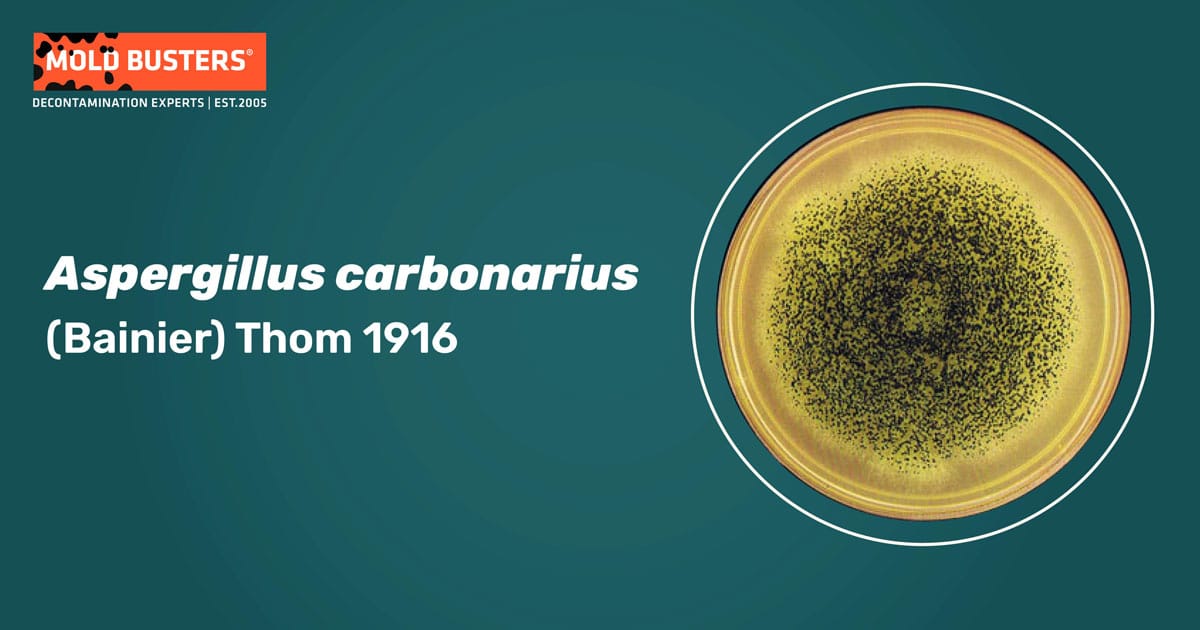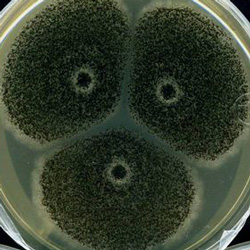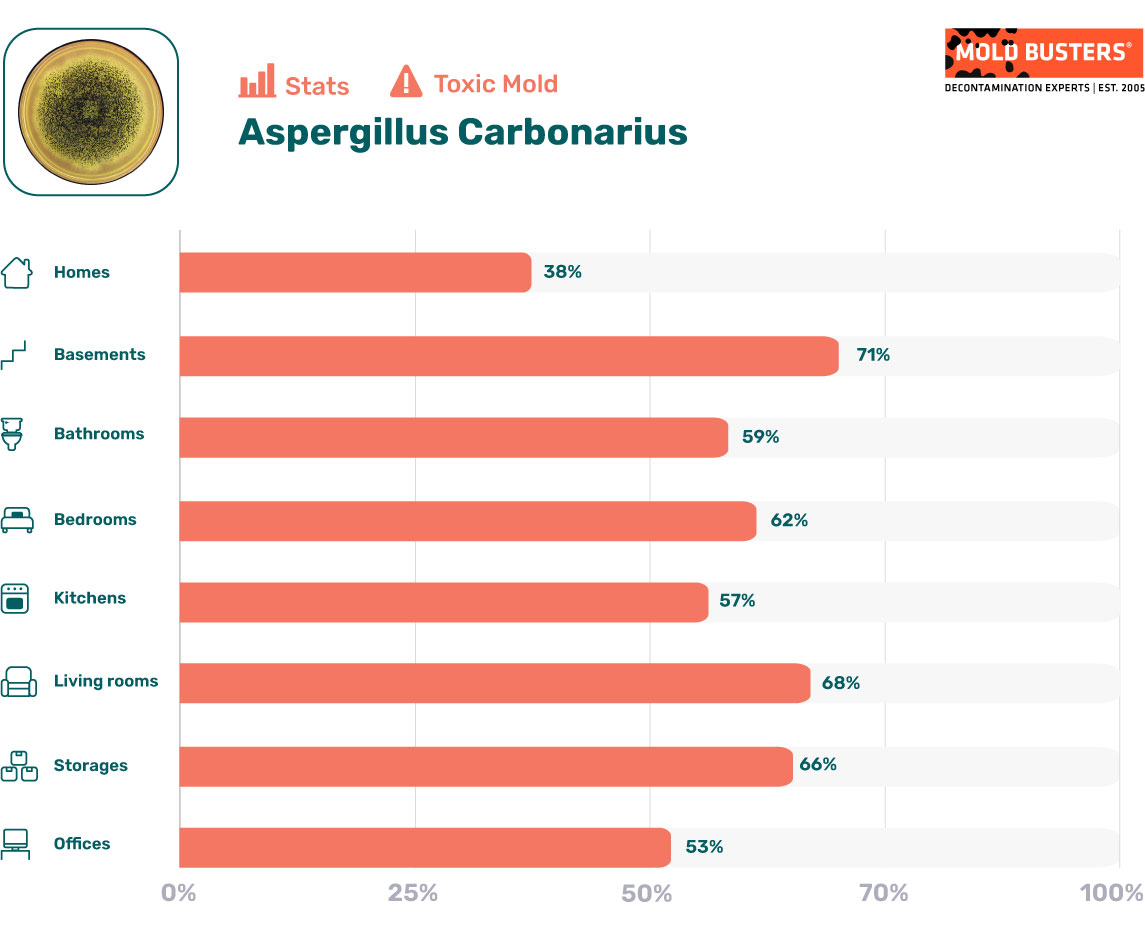(Bainier) Thom 1916
What is Aspergillus carbonarius mold?
Aspergillus carbonarius is a saprophytic mold with a worldwide distribution. It can be found in soil and on plant matter. It is a mesophyllic species, which causes Aspergillus bunch rot of grapes. A. carbonarius is a producer of Ochratoxin A, a dangerous mycotoxin. It is notorious for the rapid spread of its spores and can easily be spread without physical contact [1].

Aspergillus carbonarius taxonomy
Aspergillus carbonarius is morphologically very similar to A. niger , however, A. carbonarius produces larger spores. The two species are very closely related and share many physiological and morphological characteristics. Recently, Aspergillus carbonarius, A. niger, and other similar molds were identified as the main source of OTA in grapes from various parts of South America, Europe, and Australia [2]. The species was originally described by the French botanist Georges Bainier in 1916. It belongs to the Aspergillus genus of the Trichocomaceae family [3].
Where can Aspergillus carbonarius be found?
A. carbonarius is a saprophytic organism and can be isolated from soil and various plant material. However, the primary food-related habitat of this species is the vineyard. A. carbonarius can frequently be isolated from vineyard soil, dried berries, stems, dead canes, etc. It infects grapes from berry set to harvest, but populations increase from the onset of the ripening of the grapes. A. carbonarius can grow at a minimum of around 10°C, with the growth optimum near 30°C, and a temperature maximum near 41°C. The optimum growing water activity is at 0.96–0.98, A. carbonarius grows over a wide pH range between 2–10 [5].
Aspergillus carbonarius morphology
A. carbonarius forms approximately 60 mm (2.4 inches) diameter colonies, consisting of surface white mycelium, topped by a layer of conidiophores. Near the colony margins, individual jet black conidial heads are visible with the naked eye (Fig. 1). The colony reverse is colorless to pale yellow. Conidiophores are borne from the surface hyphae, 2.0–3.0 mm long with smooth walls. Conidia are black, nearly spherical, 6–8 µm in diameter, with roughened or spiky walls, formed in large, radiate heads [5].

Aspergillus carbonarius mold statistics
As part of the data analysis presented inside our Mold Statistics resource page, we have calculated how often mold spore types appear in different parts of the indoor environment when mold levels are elevated. Below are the stats for Aspergillus carbonarius:


Is Aspergillus carbonarius mold dangerous?
Aspergillus carbonarius is a known producer of ochratoxin A, a dangerous mycotoxin. Ochratoxin A is a polyketide derivative and a carcinogenic fungal secondary metabolite. Various molds are known to produce ochratoxins, with differences inconsistency and amounts. Among the most notable ochratoxin-producing aspergilli are Aspergillus ochraceus, A. alliaceus, A. melleus, and certain strains of A. niger. Ochratoxins contaminate products such as grains, legumes, coffee, dried fruits, beer and wine, and meats. They attack kidneys, can raise the risk of congenital disabilities, and act as carcinogens and immunotoxins in humans and animals. Risk levels depend on the levels of exposure. Prolonged exposure to these can lead to serious and irreversible kidney damage [4].
Aspergillus bach rot
While Aspergillus carbonarius contaminates various fruits, vegetables, grains, and even meats, it is most notable for infecting grapes. This species is considered to be the main fungal contaminant of grapes and grape products, including table grapes, wines, and dried vine fruits [4]. The infection causes Aspergillus bach rot. However, as A carbonarius is a saprophyte, and only an opportunistic pathogen, certain predisposing factors (insect damage, other fungal infections, mechanical damage due to unfavorable conditions are needed to start the Aspergillus bunch rot. This disease generally occurs near harvest when the sugar content of grapes is high [5].
Where can you find Aspergillus carbonarius mold in house?
Fungal spores enter your house constantly. If they are dispersed in favorable conditions (moisture and temperature), they will likely develop visible mold colonies. You should pay special attention to your bathrooms, toilets, kitchen, and other wet places which are considered to be perfect breeding grounds for this mold. Another entry point for Aspergillus carbonarius can be improperly cleaned and handled vegetables coming inside your home. It can also be found in attics, basements, garages, and backyards which are not regularly used [4].
What are Aspergillus carbonarius mold health effects?
Ochratoxin A is aflatoxin—a group of most dangerous food-contaminating mycotoxins. Contamination of food products, such as cereals and cereal products, coffee beans, dry vine fruits, wine and grape juice, spices, and licorice, occurs across the world, very often due to improper storage. Ochratoxin A is formed during crop storage and is known to have several toxic effects on humans and animals. The most negative impact on human health is kidney damage, but it may also impact fetal development and the immune system [5,6].
How to fight and remove Aspergillus carbonarius?
Aspergillus bach rot caused by the A. carbonarius can be managed by proper agricultural practices such as irrigation, and pruning to ensure needed airflow which would reduce surface moisture through vines. Additionally, the use of cover crops between rows and appropriate fungicide applications can reduce the infections of this mold [5]. Furthermore, proper fruit and vegetable hygiene before consumption is also important to reduce our risk of exposure to mycotoxins. Grain and similar products must be stored in a dry environment that prevents the growth of mold.
References
- Palma N, Cinelli S, Sapora O, Wilson SH, Dogliotti E (2007). Ochratoxin A-induced mutagenesis in mammalian cells is consistent with the production of oxidative stress. Chem Res Toxicol. 20(7):1031-7.
- Grigoriev IV, Nordberg H, Shabalov I, Aerts A, Cantor M, Goodstein D, Kuo A, Minovitsky S, Nikitin R, Ohm RA, Otillar R, Poliakov A, Ratnere I, Riley R, Smirnova T, Rokhsar D, Dubchak I (2012). The Genome Portal of the Department of Energy Joint Genome Institute. Nucleic Acids Res. 40(Database issue):D26-32.
- Kirk PM (2019). Species Fungorum (version Oct 2017). In: Species 2000 & ITIS Catalogue of Life, 26th February 2019. Digital resource at www.catalogueoflife.org/col.
- Bui-Klimke TR, Wu F (2015). Ochratoxin A and human health risk: a review of the evidence. Crit Rev Food Sci Nutr. 55(13):1860-9.
- Pitt, J. I., & Hocking, A. D. (2009). The ecology of fungal food spoilage. In Fungi and food spoilage (pp. 3-9). Springer, Boston, MA.
- WHO – Mycotoxins, source: who.int

Get Special Gift: Industry-Standard Mold Removal Guidelines
Download the industry-standard guidelines that Mold Busters use in their own mold removal services, including news, tips and special offers:

Written by:
John Ward
Account Executive
Mold Busters
Edited by:
Dusan Sadikovic
Mycologist – MSc, PhD
Mold Busters
